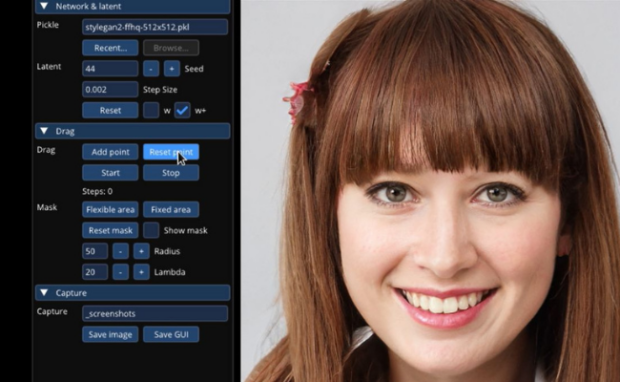DragGAN Click-And-Drag Photo Editor Went Viral
Researchers from the University of Pennsylvania released an AI-powered photo editing tool called DragGAN. It enables users to manipulate images by clicking and dragging specific parts. For example, you may pull on a person’s lips to make their image smile. The project is still under development but has gained online popularity within days.
We have seen artificial intelligence tools facilitate editing photos such as Midjourney and DALL-E. However, the UPenn AI program takes its technology to the next level by removing the need for prompts. Soon, DragGAN could herald a new age for photo manipulation tools, making it easier for everyone to achieve Photoshop-quality results.
This article will discuss the new AI program DragGAN. I will explain how it works and highlight its flaws. Later, I will elaborate on its potential global impact so you can prepare for its effects on daily life.
How does DragGAN work?
draggan has two parts: backpropping on a circle of moved pixels to find new input that moves those pixels incrementally in the right direction, and then use discriminator to get feature representation of the handle point, and use nearest neighbor search on the discriminator… pic.twitter.com/eB5OVC6FPy
— murat 🍥 (@mayfer) May 20, 2023
Penn University researchers wanted to make visual content easier to manipulate using generative adversarial networks. GANs use artificial intelligence to detect and correct data problems.
They acknowledged the old models lacked precision and flexibility as they considered all relevant data. That is why the researchers used a different approach for DragGAN.
It lets users edit a picture by attaching two points to a specific part. Specifically, the University of Pennsylvania research paper divides the AI program into two components:
- Feature-based motion supervision drives the handle point to move toward the target position.
- A new point-tracking approach leverages the discriminative generator features to keep localizing the position of the handle points.\
You may also like: How To Use Meta’s Animated Drawings Tool
The reference points allow the GAN to focus, helping it manipulate photos faster and easier. As a result, DragGAN may compete with Adobe Photoshop.
The University of Pennsylvania researchers have not released public access to their tool. Nevertheless, it gained online popularity, causing their demo website to crash due to overwhelming traffic.
DragGAN vs. Photoshop and AI photo editors

Photo Credit: jagran.com
Most people may not see the significance of the UPenn research. Consequently, I will compare their AI program with existing ones like Photoshop and Midjourney.
I will use an example to illustrate my point, such as lengthening a horse’s legs in a picture. The background must also adjust accordingly. Here’s how you do it on Adobe Photoshop:
- Use the Quick Selection tool to highlight the legs. Alternatively, use the Magic Wand tool and narrow its selection to the legs.
- Then, right-click the selection, choose the Transform menu, and select the Distort option.
- Stretch the image as you see fit. Also, improve results by using other Transform options like Skew and Scale.
- Next, select the Magic Eraser tool to remove surrounding parts that do not match the edited legs. For example, use the tool to remove awkward patches of grass or rocks.
Nowadays, you can use free AI tools like Stable Diffusion to alter your image. Submit it to the program and command it to make the horse’s legs longer.
You may need multiple trials to achieve your desired results. Consequently, using AI programs requires knowing how to make effective prompts.
Meanwhile, DragGAN significantly simplifies the process by letting you drag and drop points. Put points on the opposite ends of the leg, and drag until you achieve desired results.
The best part is that the program automatically adjusts the environment to suit the adjustments. As a result, it significantly makes it easier to alter images.
What is the potential of DragGAN?
DragGan it, they done it again.
Manipulate the pose, shape, expression and layout of just about any object.
This is Drag Your Gan: Interactive Point-based Manipulation on the Generative Image Manifold.
Incredible. Obviously, no one will use this with nefarious intent. pic.twitter.com/XdGfJ5zToY
— Roberto Nickson (@rpnickson) May 19, 2023
DragGAN is not available for consumer use yet, but we can see its boundless applications. The first is it could make it easier for everyone to alter images.
You would not need to learn how to use photo-editing programs or write effective prompts. Instead, you can push and pull on picture objects to manipulate them.
You may also like: Eating Cold Food Boosts Appetite
It would become even more prevalent once DragGAN becomes available on mobile devices. However, the tool may also promote more online misinformation.
For example, a malicious person may edit a person’s photo quickly to tarnish their public image. Others may use it to appear more desirable on online dating apps.
Conclusion
Researchers from the University of Pennsylvania are developing a drag-and-drop photo editor called DragGAN. The program significantly makes it easier to alter pictures.
The team has not opened access to the tool at the time of writing. Yet, we should expect more people worldwide to use DragGAN in the near future.
After all, ChatGPT is only months old and has become a global sensation! Keep up with the latest trends in artificial intelligence, gadgets, and more at Inquirer Tech.